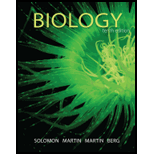
Concept explainers
A symbiotic association in which organisms are beneficial to one another is known as (a) predation (b) interspecific competition (c) intraspecific competition (d) commensalism (e) mutualism
Introduction: Elucidation and inspection of patterns and processes within a community is known as community ecology. Communities contain large number of individuals of different species those interact with each other and are independent in various ways. Every organism mostly plays one of the three important roles of the ecosystem in community life, namely producer, consumer, or decomposer.
Answer to Problem 1TYU
Correct answer: A symbiotic association in which organisms are beneficial to one another is known as mutualism. Hence the correct answer is option (e).
Explanation of Solution
Reason for correct answer:
Option (e) is given as “mutualism”.
The type of symbiosis in which both the specie are benefited by each other is known as mutualism. The relationship is obligatory in which both species need each other for survival. For example, the association between nitrogen-fixing bacteria of the Rhizobium and the plants like beans, peas and clover. Nitrogen fixing bacteria gives the plant nitrogen for the manufacturing of chlorophyll, nucleic acids, and plants and the plant supplies energy-rich organic molecules and sugar.
Hence the correct answer is option (e).
Reasons for incorrect answers:
Option (a) is given as, “predation”. The consumption of one species by another species is known as predation. Hence, option (a) is incorrect.
Option (b) is given as, “interspecific competition”. Competition occurs between members of different species and individuals with several adaptations for survival are known as interspecific competition. Hence, option (b) is incorrect.
Option (c) is given as, “intraspecific competition”. Competition occurs between same species and organisms with similar adaptations for all types of essential requirements are known as intraspecific competition. Hence, option (c) is incorrect.
Option (d) is given as, “commensalism”. The type of symbiosis in which only one species is benefited and other species remain unaffected is known as commensalism. Hence, option (d) is incorrect.
Hence the options (a), (b), (c), and (d) are incorrect.
Mutualism is a symbiotic association in which both organisms are beneficial to one another.
Want to see more full solutions like this?
Chapter 54 Solutions
Biology (MindTap Course List)
Additional Science Textbook Solutions
Biological Science (6th Edition)
Chemistry: Structure and Properties (2nd Edition)
Laboratory Manual For Human Anatomy & Physiology
SEELEY'S ANATOMY+PHYSIOLOGY
Biology: Life on Earth with Physiology (11th Edition)
- What symbolic and cultural behaviors are evident in the archaeological record and associated with Neandertals and anatomically modern humans in Europe beginning around 35,000 yBP (during the Upper Paleolithic)?arrow_forwardDescribe three cranial and postcranial features of Neanderthals skeletons that are likely adaptation to the cold climates of Upper Pleistocene Europe and explain how they are adaptations to a cold climate.arrow_forwardBiology Questionarrow_forward
- ✓ Details Draw a protein that is embedded in a membrane (a transmembrane protein), label the lipid bilayer and the protein. Identify the areas of the lipid bilayer that are hydrophobic and hydrophilic. Draw a membrane with two transporters: a proton pump transporter that uses ATP to generate a proton gradient, and a second transporter that moves glucose by secondary active transport (cartoon-like is ok). It will be important to show protons moving in the correct direction, and that the transporter that is powered by secondary active transport is logically related to the proton pump.arrow_forwarddrawing chemical structure of ATP. please draw in and label whats asked. Thank you.arrow_forwardOutline the negative feedback loop that allows us to maintain a healthy water concentration in our blood. You may use diagram if you wisharrow_forward
- Give examples of fat soluble and non-fat soluble hormonesarrow_forwardJust click view full document and register so you can see the whole document. how do i access this. following from the previous question; https://www.bartleby.com/questions-and-answers/hi-hi-with-this-unit-assessment-psy4406-tp4-report-assessment-material-case-stydu-ms-alecia-moore.-o/5e09906a-5101-4297-a8f7-49449b0bb5a7. on Google this image comes up and i have signed/ payed for the service and unable to access the full document. are you able to copy and past to this response. please see the screenshot from google page. unfortunality its not allowing me attch the image can you please show me the mathmetic calculation/ workout for the reult sectionarrow_forwardIn tabular form, differentiate between reversible and irreversible cell injury.arrow_forward
 Biology (MindTap Course List)BiologyISBN:9781337392938Author:Eldra Solomon, Charles Martin, Diana W. Martin, Linda R. BergPublisher:Cengage Learning
Biology (MindTap Course List)BiologyISBN:9781337392938Author:Eldra Solomon, Charles Martin, Diana W. Martin, Linda R. BergPublisher:Cengage Learning Concepts of BiologyBiologyISBN:9781938168116Author:Samantha Fowler, Rebecca Roush, James WisePublisher:OpenStax College
Concepts of BiologyBiologyISBN:9781938168116Author:Samantha Fowler, Rebecca Roush, James WisePublisher:OpenStax College Biology Today and Tomorrow without Physiology (Mi...BiologyISBN:9781305117396Author:Cecie Starr, Christine Evers, Lisa StarrPublisher:Cengage Learning
Biology Today and Tomorrow without Physiology (Mi...BiologyISBN:9781305117396Author:Cecie Starr, Christine Evers, Lisa StarrPublisher:Cengage Learning Human Biology (MindTap Course List)BiologyISBN:9781305112100Author:Cecie Starr, Beverly McMillanPublisher:Cengage Learning
Human Biology (MindTap Course List)BiologyISBN:9781305112100Author:Cecie Starr, Beverly McMillanPublisher:Cengage Learning





